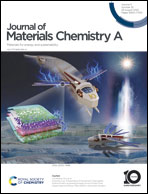Suppressing carbon corrosion via mechanically mixing transition metal phosphide clusters: a comparative in situ study in alkaline media†
Abstract
Carbon-based electrocatalysts find wide application in emerging energy conversion and storage devices. Yet they are prone to corrosion at high anodic potentials, causing severe degradation of electrochemical performance. Developing a practical strategy of suppressing carbon oxidation remains a grand challenge, particularly in alkaline electrolytes where the lack of in situ characterization approaches makes the understanding of the potential-resolved behaviors of carbon problematic. In this work, we developed a cell of differential electrochemical mass spectrometry (DEMS), which enabled us to sensitively analyze the evolution of acidic gases and to monitor carbon corrosion under operando conditions in alkaline media. We experimentally identified that CO2 was the dominant oxidation product at high potentials in 0.1 M KOH. Importantly, mechanically mixed FeP–CoP micro-clusters, with a minimized length of the interface with carbon, were effective in suppressing the corrosion of both Vulcan XC-72R carbon and N-doped carbon (NC) below 2.0 VRHE that was ca. 400 mV higher than that obtained on pure carbons. A robust bifunctional catalyst comprising 25 wt% mixed phosphide and NC was highly active in both oxygen reduction and oxygen evolution reactions, hardly showing signs of corrosion after biasing at 2.0 VRHE. Our in situ study approach together with the facile strategy of suppressing carbon corrosion cast light on understanding the mechanism of carbon oxidation, opening up new opportunities of stabilizing carbon-based electrodes for various real-life applications.



 Please wait while we load your content...
Please wait while we load your content...